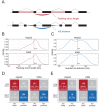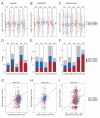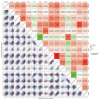The RNA-binding protein SFPQ preserves long-intron splicing and regulates circRNA biogenesis in mammals
- PMID: 33476259
- PMCID: PMC7819710
- DOI: 10.7554/eLife.63088
The RNA-binding protein SFPQ preserves long-intron splicing and regulates circRNA biogenesis in mammals
Abstract
Circular RNAs (circRNAs) represent an abundant and conserved entity of non-coding RNAs; however, the principles of biogenesis are currently not fully understood. Here, we identify two factors, splicing factor proline/glutamine rich (SFPQ) and non-POU domain-containing octamer-binding protein (NONO), to be enriched around circRNA loci. We observe a subclass of circRNAs, coined DALI circRNAs, with distal inverted Alu elements and long flanking introns to be highly deregulated upon SFPQ knockdown. Moreover, SFPQ depletion leads to increased intron retention with concomitant induction of cryptic splicing, premature transcription termination, and polyadenylation, particularly prevalent for long introns. Aberrant splicing in the upstream and downstream regions of circRNA producing exons are critical for shaping the circRNAome, and specifically, we identify missplicing in the immediate upstream region to be a conserved driver of circRNA biogenesis. Collectively, our data show that SFPQ plays an important role in maintaining intron integrity by ensuring accurate splicing of long introns, and disclose novel features governing Alu-independent circRNA production.
Keywords: SFPQ; alternative splicing; chromosomes; circular RNA; gene expression; human; mouse; premature termination.
© 2021, Stagsted et al.
Conflict of interest statement
LS, EO, KE, TH No competing interests declared
Figures






















Similar articles
-
Insights into the biogenesis and potential functions of exonic circular RNA.Sci Rep. 2019 Feb 14;9(1):2048. doi: 10.1038/s41598-018-37037-0. Sci Rep. 2019. PMID: 30765711 Free PMC article.
-
Arginine methylation and citrullination of splicing factor proline- and glutamine-rich (SFPQ/PSF) regulates its association with mRNA.RNA. 2015 Mar;21(3):347-59. doi: 10.1261/rna.045138.114. Epub 2015 Jan 20. RNA. 2015. PMID: 25605962 Free PMC article.
-
DNMT3A-mediated high expression of circ_0057504 promotes benzo[a]pyrene-induced DNA damage via the NONO-SFPQ complex in human bronchial epithelial cells.Environ Int. 2022 Dec;170:107627. doi: 10.1016/j.envint.2022.107627. Epub 2022 Nov 10. Environ Int. 2022. PMID: 36399942
-
The Emerging Role of the RNA-Binding Protein SFPQ in Neuronal Function and Neurodegeneration.Int J Mol Sci. 2020 Sep 28;21(19):7151. doi: 10.3390/ijms21197151. Int J Mol Sci. 2020. PMID: 32998269 Free PMC article. Review.
-
Circular RNA Formation and Degradation Are Not Directed by Universal Pathways.Int J Mol Sci. 2025 Jan 16;26(2):726. doi: 10.3390/ijms26020726. Int J Mol Sci. 2025. PMID: 39859439 Free PMC article. Review.
Cited by
-
ESRP1 controls biogenesis and function of a large abundant multiexon circRNA.Nucleic Acids Res. 2024 Feb 9;52(3):1387-1403. doi: 10.1093/nar/gkad1138. Nucleic Acids Res. 2024. PMID: 38015468 Free PMC article.
-
ADARs act as potent regulators of circular transcriptome in cancer.Nat Commun. 2022 Mar 21;13(1):1508. doi: 10.1038/s41467-022-29138-2. Nat Commun. 2022. PMID: 35314703 Free PMC article.
-
Viral Circular RNAs and Their Possible Roles in Virus-Host Interaction.Front Immunol. 2022 Jun 17;13:939768. doi: 10.3389/fimmu.2022.939768. eCollection 2022. Front Immunol. 2022. PMID: 35784275 Free PMC article. Review.
-
The role of long non-coding RNAs and circular RNAs in cervical cancer: modulating miRNA function.Front Cell Dev Biol. 2024 Feb 16;12:1308730. doi: 10.3389/fcell.2024.1308730. eCollection 2024. Front Cell Dev Biol. 2024. PMID: 38434620 Free PMC article. Review.
-
Emerging Role of Circular RNA-Protein Interactions.Noncoding RNA. 2021 Aug 4;7(3):48. doi: 10.3390/ncrna7030048. Noncoding RNA. 2021. PMID: 34449657 Free PMC article. Review.
References
Publication types
MeSH terms
Substances
Associated data
- Actions
- Actions
- Actions
LinkOut - more resources
Full Text Sources
Other Literature Sources
Molecular Biology Databases

